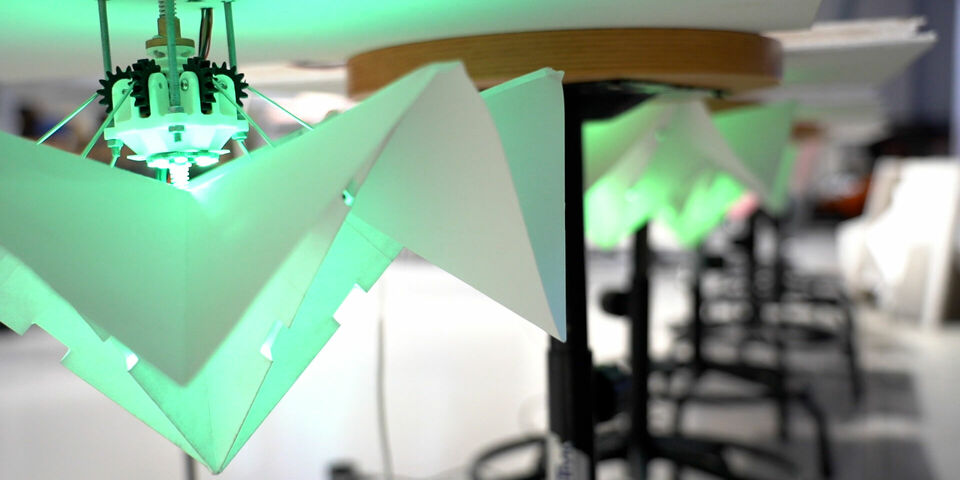It’s already dark outside when four master’s students enrolled in the ISP: innovation through art & design course at innoSpace put the finishing touches on their art installation. They use duct tape to attach paper origami shapes to a corkscrew-like mechanism, which will fold in and out the shapes with a little engine. In the meantime, Olivier Blom of Team IGNITE – who supports the students in their project – tests whether the connections are working and whether the paper shapes light up in the right color.
For this innoSpace course, master’s students of different departments team up with artists to work on challenges. These often involve external clients, but these students’ one is slightly less external. The Eindhoven Artificial Intelligence Systems Institute (EAISI) wanted a piece of art in Neuron to make the presence of the institute in the building more visible. Together with artist Martijn van Boven and with the help of Team IGNITE and NEURAL, three master’s students of Industrial Design and one of Nuclear Fusion accepted the assignment. This evening they will reveal the end result: a moving light installation made of paper.
As mundane as paper
The piece of art As mundane as paper consists of paper origami shapes suspended from the ceiling. There is also a punch card reader, which can be fed punch cards in three different colors. The piece of art will then visualize what would happen if a neural network had to learn to recognize a color. For instance, if the punch card is purple, the paper shapes will first display different colors, which then start to get closer and closer to the original purple color.
The piece of art itself doesn’t contain any AI, it’s only a representation of how artificial intelligence works. The students consciously chose to emphasize the mundaneness of AI, as opposed to the typical dystopian images of robots taking over the world. The paper material symbolizes that mundaneness, because – just like artificial intelligence – it’s present everywhere. ‘We often overlook it, yet it stores information, expresses ideas, and facilitates communication,’ the description of the piece of art reads. ‘AI is following a similar path, quietly operating in the background, subtly impacting our daily lives.’
The students wanted to make something tangible, exactly because AI is so intangible, says developer of the course Isolde Hallensleben. “All four of them set out to explore materials and came back here at the same time with paper, each of them for a different reason. For example, it was one of the oldest information carriers and was a nice element of those punch cards, which also contain references to Neuron.”
The way they arrived at this end product is typical of how the Art+Tech course works, says Hallensleben. “Students learn to think abstractly, to open themselves up to all possibilities, and to deal with now knowing where something is going.” For example, one element of the art installation is a punch card reader, which the students found in the basement of Neuron. “They didn’t only set out to research the current state of affairs when it comes to AI, but they also literally strolled across the campus and looked around. That’s a very different working method than coming up with something beforehand.”
Article continues below the video.
To use the device, and take it apart, the students had to get permission from the heritage committee. This decided they could use it, but only if it could be returned to its original state. In the art project, just the exterior and the old button – which the students say is rather unreliable – were used; the mechanical and digital components on the inside were designed by the students themselves. A visit to the quality committee was also required, says Hallensleben. “None of us had ever had any dealings with this committee that governs the esthetics on campus. It was super funny to present the plan there and be asked all of these questions. The people that came after us had to present a desk in Metaforum, which I never even realized was necessary.”
According to Hallensleben, this made this challenge different than all other ones. “We all got to know the university better thanks to it. I also thought it was important that the students came with me to the committee because it was so ‘real life’. And the same goes for the heritage committee.” Although the quality committee approved the piece of art, Hallensleben says it’s not yet clear how long it will stay at Neuron. “We’re looking into having other students elaborate on it in a while. This would make it a kind of dynamic piece of art, which would go nicely with the context of AI.”
If you would like to see the piece of art (and raise your glass to it), you’re warmly invited to its revealing in EAISI at 4:45 pm.



Discussion